I’m digging down to the code fragments of some of my first technology work, finding but fragments and relics in the layers bit dated 1992-1994.
I credit/blame Tom
Cc @cogdog https://t.co/d86h5phOyj
— Tom Woodward (@twoodwar) August 19, 2017
I had briefly seen mention of the Internet Archive’s collection of Hypercard Stacks using a webpased eumlator. The current collection has over 3000 classics that anyone can run in a modern browser.
And as replied to Tom, I totally dig the interface of the site where you can upload old stacks to the Archive; it completely feels like OS 9.
Sidebar: Ward Cunningham prototyped the first wikis based on HyperCard stacks he built — see http://wiki.c2.com/?HyperCard
It’s been part of my own narrative of my start in ed-tech in 1992, how I taught myself scripting in Hypercard, learning from stuff I downloaded from the Stanford Sumex-Aim InfoMac archive. I totally saw Hypercard as a personal information toolkit.. but was my hindsight nostalgic rosy glasses? I did not start this blog until 2002, so my first ten years of work is unblogged.
What I do have is my own archive of the first web work I did at the Maricopa Community Colleges, the Maricopa Center for Learning & Instruction.
I have but digital bones and inferences left in the mud. And fading memories.
Two years ago I did some poking around with the OS 9 emulator that allowed me to run my old Mac projects, including stuff done in Director, using the Sheepshaver emulator. In a pinch I have a 2002 Mac iBook still working that natively runs OS 9.
So I went digging in my own archives to find my early work in Hypercard… and came up a bit incomplete, as it goes with archaeology and especially of digital artifacts now more than 20 years old.
The funny thing is, considering my preparation for teaching a thesis seminar, is that two of these early projects were related to… research methods!
I tinkered around with a lot of throwaway stacks learning how to author (and thus, most are thrown away). One I found was a map of the area in California I studied for my MS Thesis, where you could click on section to see it bigger, plus a pop up window that showed a color image of the satellite image I used in my thesis.
This is one I managed to upload to the Internet Archive… and it does not work. I am guessing I was using some xcmds for opening external windows. But it is fun to watch the little mac emulator start up (way faster than the Macs did).
Here is a screen recording of the emulator loading, opening the stack, and watching me click in vain as nothing works. Blame the author of the stack!
I made ones that managed a set of quotes, a collection of images like a photo album, a few random word scramble, some kind of car button interface for controlling audio, ones that operated video discs (remember those?) I cannot get any of them to work (now getting some kind of error codes in my desktop emulator).
One of my first efforts beyond tinkering was meant to solve the problem I heard from my first week and last week in the jb at Maricopa- in such a large system, where there was a lot of innovation, it was a challenge to know “who was doing what”. Our office organized a lot of system wide activities to address that, but it became a thing I started calling a “Database of Dreams”.
Before I got there they did a lot of this in survey and print report forms. I found a screenshot of a HYpercard thing I must have built as a prototype.
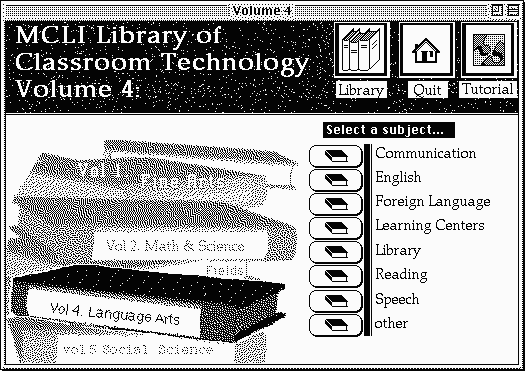
The problem always was people wanted this resource, but getting their info in there was… along the lines of organ extraction. I later tried this as a web-based thing, with a form submission , the Teaching & Learning on the Web (Internet Archive) was broader than Maricopa, but was aimed at building a large collection of ways the web was used in different subjects.
Around 2000, I did build my last effort at this idea, the Maricopa Learning Exchange (MLX)
This project cracked a bunch of things open for me, maybe the first big one developed out in PHP over my previous work in perl, but also the concept of representing big and small practices of teaching as a metaphor of “packages” where each one had a “packing slip” (aka metadata).
It also got me deep into building RSS feeds into the way the site was published, to get feeds by soptic, or from one college, or from search results. It was my RSS junkie days.
But going back to Hypercard, my first “real” project I remember doing with a Maricopa faculty member was working with English teacher Rod Freeman at Estrella Mountain Community College on an idea he had for his ENG 102 students. It was called Research Mentor (and it was a Hypercard stack, but I had a fancy color opening screen).
As an aside, that image I believe was generated in Strata3D. The photos were left to right, a photo I took on a hiking trip with city kids where one boy found a baby turtle, pyramids created for another project by a student worker named Tony, and I think a photo I took in Germany. Memory…
I do not even have this HyperCard stack. It may not have ever been fully finished. I do have a description of the project Rod wrote for our MCLI Labyrinth newsletter (February 1993):
English 102, the continuation of English writing skills, is a class with a high attrition rate district-wide. In addition to developing the writing skills underway from English 101 it serves to introduce the student to research – in fact, it may be the only “research” class students will take to prepare them for research-oriented upper-division classes. Added to this, the information explosion of the last decade brings myriad information databases to the fingertips of the researcher- writer. Traditional classroom methods of research paradigms are not ideally structured to allow the learner to easily access diverse archives of electronic data. Given high attrition rates and the overwhelming mass and interconnectivity of information, a possible answer arises. A mentor for the student. From this need the Research Mentor is developed – an organizational template/menu to mentor the student through the research-composition process.
Rather than have a program matched to one text or to one philosophy of research, I wished to create an adaptive program which would address as many diverse learning styles as possible. The aim of this package was an organizational template to be utilized outside the classroom to focus student effort – teaching research as a recursive process. Students refer to the Electronic Forum for their assignments. Through modules the students learn to focus their topic, compile a preliminary annotated bibliography, avoid plagiarism, take effective and useful notes; paraphrase, summarize, and quote material; develop effective thesis statements; plan composition through outlines; distinguish between fact and opinion; write the rough draft; document the research paper; and successfully answer essay questions. In addition to these competencies, students become acquainted not only to the traditional paper resources, but also to the electronic dimensions of research. Students will use Electronic Forum and Internet to communicate with local, national, and international students and forums, electronic atlases for demographic and geographic information, electronic encyclopedia and dictionaries, multimedia resources, electronic databases and on-line catalogs and other resources. The philosophy of each module is to introduce the research resource, show how it integrates with other resources, provide practice in utilizing the resource, and provide the student with actual practice, relevant to the individual learner, in utilizing the resource to meet the course competencies.
What I did find was something I made in Hypercard, a slideshow walkthrough of screens. Since it’s not playable, I made a screen recording of me showing screen shots… pottery shards and bone fragments!
There was quite a bit of complexity in there, an ability for users to create and save notebooks, give feedback, launch external apps (the Electronic Forum was a Maricopa home grown BBS system that was widely used in the 1980s and early 1990s).
It’s worth mentioning the newsletter I quoted above. The Labyrinth-Forum was written by our office staff and Maricopa faculty, published and sent out in print form by intercampus mail. I got it in my head early to create digital versions. Sometime in 1993 I was trying to develop a Hypercard version of the articles, then running it through a program that converted it to Toolbook (since we had both a lot of Macs and PCs in the system).
It was a mess.
And that drove me to investigate the possibility of this new thing in 1993 called The World Wide Web, to learn and write lessons in HTML. Doing our newsletter in web form made a lot more sense for many reason, the rest is sort of history. I have the entire archive of our publications 1993-2001 and then 2001-2006 in a more modern (for then) layout.
Can I say that like Ward Cunningham, experiments in Hypercard led me to the web?
Another Hypercard memory of my early days at Maricopa. When I arrived as a … it was not even “Instructional Technologist” then, I started as a “Programmer / Analyst Instructional Systems”… there was a long lived project at the Maricopa Center for Learning & Instruction.
I was told that Learning English Electronically, a collection of grammar and vocabulary lessons for ESL students, had been designed pre-microcomputers. Some work had been done on a main frame tool, then some interns built bits of it in Authorware, and by the time I arrived, two interns from ASU were working on it in HyperCard.
It was maybe a year or two in, now with some HyperCard chops under my belt, I was asked to “get it done.” What I found was a lot, a lot of stacks, all with duplicated code, and a lot of internal inconsistencies. But more than that, since the work had started a few years ago, it was still at those 9″ Mac screens in black and white.
I was looking at this software on the shelves called “Macromedia Director” and what found was a better platform (it could publish for both Macs and PCs) for doing multimedia, it was larger screen (which may have been a whopping 640×480), in color, and it handled audio well.
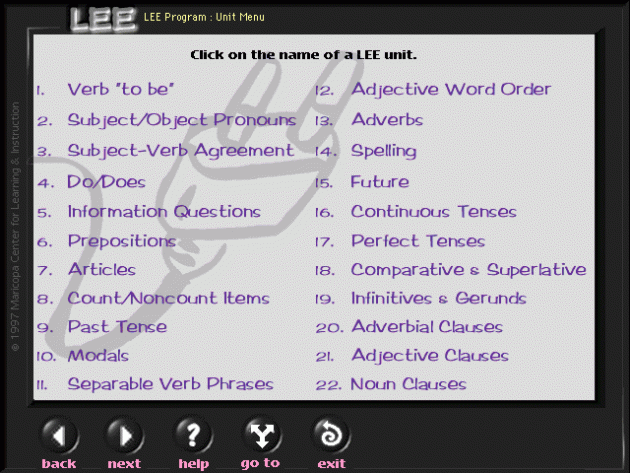
Lee Units
Those are the 22 units, within each one was a lesson in five different themed categories
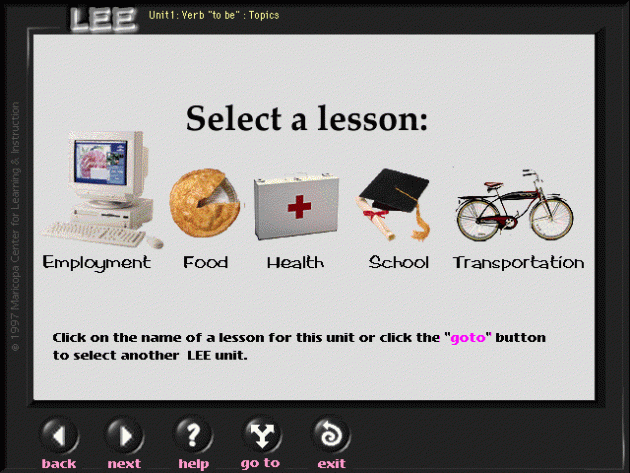
Each lesson had text and audio, followed by interactive practice and an assessment. There was a lot to it. We had the entire content available in print form as well. This too was my first published CD-ROM; we ordered one of the first CD writers, but later had LEE mass produced and given out to all ten Maricopa colleges, plus we took orders and sold maybe 1500 of them (at just enough to pay the cost of duplication).
That was a diversion, but the limits HyperCard was in some ways good in propelling me to look at another software. All of the LEE info is now archived at http://mcli.cogdogblog.com/proj/lee.
Maybe my last HyperCard project was Research Methods in Social and Natural Sciences. It was an idea from Scottsdale Community College Psychology teacher Bernie Combs, perhaps it was a submission for a grant from our center. I think he had a prototype built in HyperCard; I made use of color, a larger screen, and some advanced (hah) programming for keeping track of progress and assessment.

The idea was to provide an overview of strengths and limitations of five methods of research, and provide real examples of each as used in 4 different disciplines.

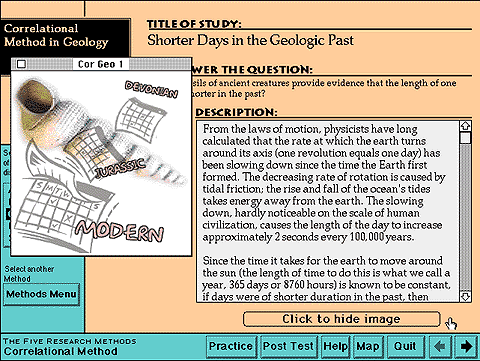
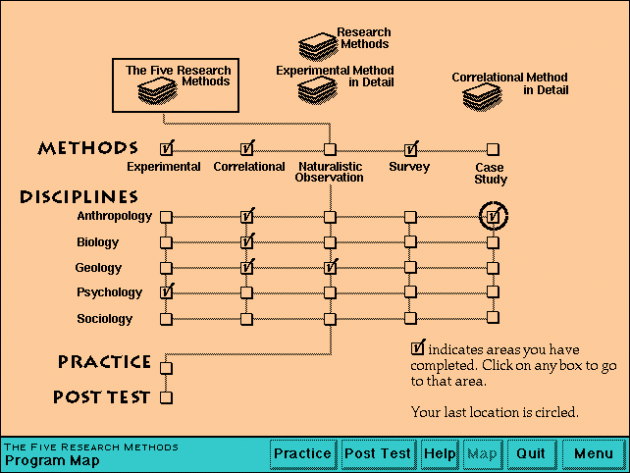
Unfortunately when I was testing, it seemed to crash on the practice and assessment. And no, I am not going to debug it.
I forgot why or when, but later I decided to convert this into a web0based version, which is still available at http://mcli.cogdogblog.com/proj/res_meth/index.html
Alas, the practice and assessment don’t work because I built them in Shockwave.
There it is, a few windows into my Hypercard archeology. There might be more down in the bottom of the trench. I am not sure what it really tells about the civilization. The bigger projects worked well because they had solid content, pedagogy and instructional design behind them. And a lot of the work in Hypercard seemed to take me on a path to the web.
I am struck too at how little I have as far as my own thinking and documenting of the building process. By the time I started blogging, Hypercard was way in my rear view mirror.
With that perspective, the past classics of Hypercard is epic.
Featured image: Modified by adding screenshot Hypercard icon and tool palette to Archeological dig continues to discover new artifacts on USACE construction site in Wiesbaden flickr photo by USACE Europe District shared under a Creative Commons (BY) license


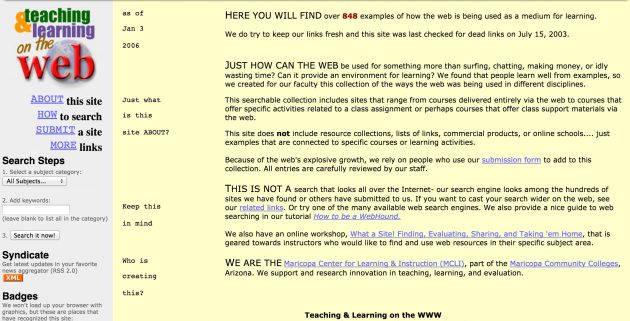





I am glad for the small part I played in this endeavor.
Interesting post Alan. I have been thinking a lot lately about the age of blogging and the way that it is implemented in (and out of) schools. One of the things that I am intrigued by is when a blog is used as a platform to support learning portfolios in K-12. I have met so many people who tell me ‘we did blogs, didn’t work’, yet if you were to look at their approach the only way it is to work is by sticking to it long term. However, long term seems to be an interesting proposition. For example, you mentioned Shockwave. How many other add-ons and applications are there that fit this ilk. What is offered to schools by a platform like Seesaw is slick, yet it has evolved in its first few years. I wonder what it will look like in a few years time and how students will meaningfully archive this material (without downloading a bunch of seemingly files, is that meaningful?) Anyway, just a few thoughts.
I can only make some general wide conjectures. Blogging is not likely to become a wide spread activity, as are things which call for long term commitment and practice (running marathons, playing a musical isntrument at a performance level), as well as a personal motivation. I would guess i many places it is a one class or one teacher effort, so for students it ends up bing more like an assignment.
The platform question I can be more definite and in hindsight– I’m not interest any more in technologies that are dependent on non-standard platforms or lack tools for import / export. I can’t say at the time I gave thought to the long term viability of HyperCard or Shockwave, they seemed reliable and viable. Everything though I have done in HTML, CSS, Javascript, Mp4, Mp3 is still functioning; my first web pages form 1994, though simple, still function 23 years later.
That does not mean that tools like Seesaw (which I have not seen) are not useful, but it’s a question to think about for ones that produce content.
Yes, hindsight helps a lot!